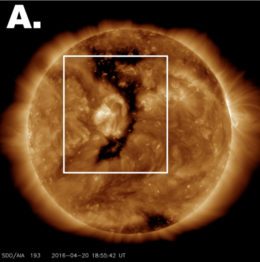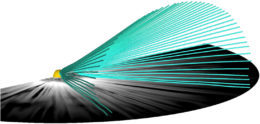Plasma from the Sun known as the slow solar wind has been observed far away from where scientists thought it was produced. Now new simulations may have resolved the puzzle of where the slow solar wind comes from and how it escapes the Sun to travel through our solar system.
An Origin Puzzle

A full view of a coronal hole (dark portion) from SDO. The edges of the coronal hole mark the boundary between open and closed magnetic field lines. [SDO; adapted from Higginson et al. 2017]
This second type of region — known as a coronal hole — is thought to be the origin of fast-moving plasma measured in our solar system and known as the fast solar wind. But we also observe a slow solar wind: plasma that moves at speeds of less than 500 km/s.
The slow solar wind presents a conundrum. Its observational properties strongly suggest it originates in the hot, closed corona rather than the cooler, open regions. But if the slow solar wind plasma originates in closed-field regions of the Sun’s atmosphere, then how does it escape from the Sun?
Slow Wind from Closed Fields
A team of scientists led by Aleida Higginson (University of Michigan) has now used high-resolution, three-dimensional magnetohydrodynamic simulations to show how the slow solar wind can be generated from plasma that starts out in closed-field parts of the Sun.
Motions on the Sun’s surface near the boundary between open and closed-field regions — the boundary that marks the edges of coronal holes and extends outward as the heliospheric current sheet — are caused by supergranule-like convective flows. These motions drive magnetic reconnection that funnel plasma from the closed-field region onto enormous arcs that extend far away from the heliospheric current sheet, spanning tens of degrees in latitude and longitude.The simulations by Higginson and collaborators demonstrate that closed-field plasma from coronal-hole boundaries can be successfully channeled into the solar system. Due to the geometry and dynamics of the coronal holes, the plasma can travel far from the heliospheric current sheet, resulting in a slow solar wind of closed-field plasma consistent with our observations. These simulations therefore suggest a process that resolves the long-standing puzzle of the slow solar wind.
Bonus
Check out the animation below, made from the results of the team’s simulations. This video shows the location of a forming heliospheric arc at a distance of 12 solar radii. The arc forms as magnetic field lines at the boundary of a coronal hole change from closed to open, allowing closed-field flux to escape along them.
Citation
A. K. Higginson et al 2017 ApJL 840 L10. doi:10.3847/2041-8213/aa6d72



4 Comments
Pingback: slow solar winds origin
Pingback: Escape for the Slow Solar Wind – New
Pingback: Escape para el viento solar lento – Observatori Astronòmic
Pingback: Viento solar lento « SEDA / LIADA - RedLIADA - Cursos LIADA - Cielo del Mes - Fenómenos Astronómicos - RELEA